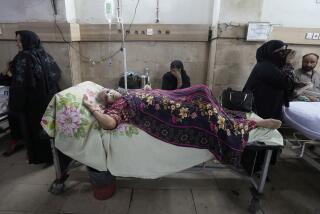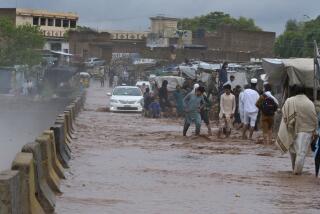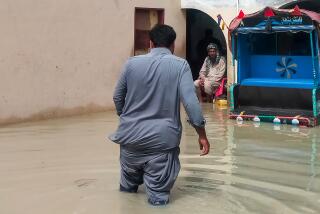Pakistan Fears 18,000 Died in Quake
BALAKOT, Pakistan — More than 18,000 people were killed when a powerful earthquake struck northern Pakistan, a military spokesman said today, in a disaster that entombed hundreds of children in their schools, flattened a high-rise apartment building in the Pakistani capital and devastated an untold number of villages.
The magnitude-7.6 quake struck just after 8:50 a.m. Saturday in the disputed region of Kashmir and reverberated across a swath of northern Pakistan, India and Afghanistan. The epicenter was in a mountainous region about 60 miles northeast of Islamabad, Pakistan’s capital, the U.S. Geological Survey said.
Military spokesman Maj. Gen. Shaukat Sultan told Pakistan’s Geo television network today that 17,000 of the dead were in the Pakistan-controlled part of Kashmir. Thousands more were wounded and missing. In India, the death toll was in the hundreds.
But rescue teams have yet to reach many areas, including Balakot, a town in northern Pakistan that was reduced to rubble. Residents said that at least 5,000 people were killed in the town, but that number could not be confirmed.
Hundreds more were missing in the debris in Balakot, including many children buried in the wreckage of 10 schools, the residents said. With rescuers thwarted by landslides and heavy rainfall, parents clawed through the rubble for their children.
A woman who gave her name only as Saira sat in the ruins next to her child’s body. “I have lost everything,” she said. “This is God’s wrath.”
“Where are the rescuers? No one has reached us,” teacher Junaid Ahmed said. “Do they think that Islamabad is more important than Balakot?”
In the town of Garhi Habibullah, residents said that about 300 bodies had been recovered from the ruins of a girls school there. Five hundred students were injured.
“Many villages have been wiped out in the earthquake-hit areas of the province,” a witness, Abdul Makjeed, said by phone from Mansehra, near Garhi Habibullah, and the worst-affected area.
In Islamabad, rescuers worked into the night trying to save scores of people believed trapped in the rubble of an apartment complex in an upscale district of the capital that counted foreign nationals among its residents. At least 20 people were killed and 85 others injured when one building in the Margalla Towers complex collapsed and another was severely damaged.
Soon after the quake struck, Pakistani President Pervez Musharraf said the country’s armed forces had helicopters and C-130 transport planes ready to bring emergency relief supplies to the affected areas, which are at the center of more than one geopolitical drama.
A Pakistani military spokesman said more than 200 troops in northern areas of Pakistan were reported killed in the quake. Pakistan’s military has numerous bases in the region, especially in Kashmir.
Both India and Pakistan claim sovereignty over the Himalayan region, and the dispute has caused two of the three wars between the two countries since Britain granted the subcontinent independence in 1947.
About 300 people died in the Indian-controlled portion of Kashmir, and scores of homes were damaged or destroyed in the region, said Mansoor Hussain, spokesman for India’s chief minister in the territory. And more than 500 people were injured and 1,100 houses damaged or destroyed, Hussain said by telephone from Srinagar, summer capital of India’s Jammu and Kashmir state. Heavy rain complicated relief efforts in the Kashmir Valley.
But perhaps hardest hit was Pakistan’s North-West Frontier Province, a territory bordering Afghanistan that Afghan intelligence officials say Taliban militants have used as a base for cross-border attacks. Residents of the Mansehra area said the bases, which had been closed after a government crackdown, reopened in the spring. Pakistan’s government denies the allegations.
The rugged border region is considered a possible hiding place for Osama bin Laden. But senior Afghan and Pakistani officials said earlier this year that they didn’t think the Al Qaeda leader was in their territories.
In Islamabad, U.S. Ambassador Ryan Crocker said a U.S.-Pakistani airborne surveillance unit had been authorized to provide helicopters for the relief effort. After the Sept. 11 attacks, the U.S. helped set up the Ministry of Interior Air Wing to conduct border surveillance in the fight against terrorists and drug traffickers.
“The U.S. military has offered assistance to their Pakistani counterparts to provide appropriate supplies and assistance for relief efforts,” the embassy said in a statement on its website.
Crocker also said he would release $100,000 at his disposal for disaster relief.
There were no immediate reports of American casualties in the region. A State Department spokesman in Washington said all U.S. Embassy personnel in Islamabad were accounted for. The earthquake was felt in Afghanistan, where about 18,000 U.S. forces are deployed, but the military said the temblor was not strong enough to cause major damage.
At the White House, spokesman Ken Lisaius said President Bush was briefed on the earthquake and “the terrible loss of life it has caused.”
“The thoughts and prayers of the president and first lady are with the families, friends and loved ones of the victims,” Lisaius said.
Secretary of State Condoleezza Rice said in a statement that she spoke with the foreign ministers of Pakistan and India on Saturday morning and offered sympathy and assistance.
“At this difficult time,” she said, “the United States stands with its friends in Pakistan and India, just as they stood with us and offered assistance after Hurricane Katrina.”
During a visit to the ruined apartment complex in Islamabad, Musharraf said, “In the overall context, it is a test for all of us, the entire nation, and we are sure we will meet this test.”
Dressed in his army general’s uniform, Musharraf stumbled over large chunks of concrete as he surveyed the collapsed buildings.
Pakistan’s military said hundreds of troops were dispatched to quake-hit areas from Peshawar, the capital of North-West Frontier Province, where troops were also on standby in case of unrest.
Two helicopters loaded with doctors, engineers and medicine have left Peshawar for Mansehra to coordinate relief activities in the affected areas, a military statement said. But poor visibility and bad weather were hampering rescue operations in some areas of northwestern Pakistan, officials said.
The quake was the worst to hit Pakistan in at least 20 years. A more powerful magnitude-7.7 quake struck the Indian state of Gujarat in 2001, killing nearly 20,000 people and injuring about 166,000. That earthquake, whose epicenter was in the city of Bhuj, destroyed 783,000 buildings, most of them village homes.
Saturday’s quake was slightly more than 6 miles underground.
About 500 miles away, in the Indian capital, New Delhi, the earthquake was strong enough to make buildings sway for at least a minute. Indian Prime Minister Manmohan Singh expressed shock over the quake’s destruction and pledged to pay $2,000 in compensation to the next of kin of anyone who died in the quake.
Chief Minister Mufti Mohammed Syed, the leader of Jammu and Kashmir state, tried to tour the quake zone Saturday but was forced to flee an angry crowd demanding that the government deliver more emergency aid.
India’s army set up camps to provide rations and tents for quake victims in Uri and Poonch districts, two areas where militants who India says are supported by Pakistan frequently attack the security forces.
“Helicopters from the Indian air force have been pressed into service and are carrying doctors and evacuating patients for treatment,” said Indian army spokesman Col. Sudhir Kumar Sakuja.
At least 25 Indian troops died in Uri district when barracks and bunkers collapsed.
Times special correspondent Zaidi reported from Balakot, staff writer Watson from New Delhi and special correspondent Ali from Peshawar. Times staff writer Ricardo Alonso-Zaldivar in Washington contributed to this report.
More to Read
Sign up for Essential California
The most important California stories and recommendations in your inbox every morning.
You may occasionally receive promotional content from the Los Angeles Times.










